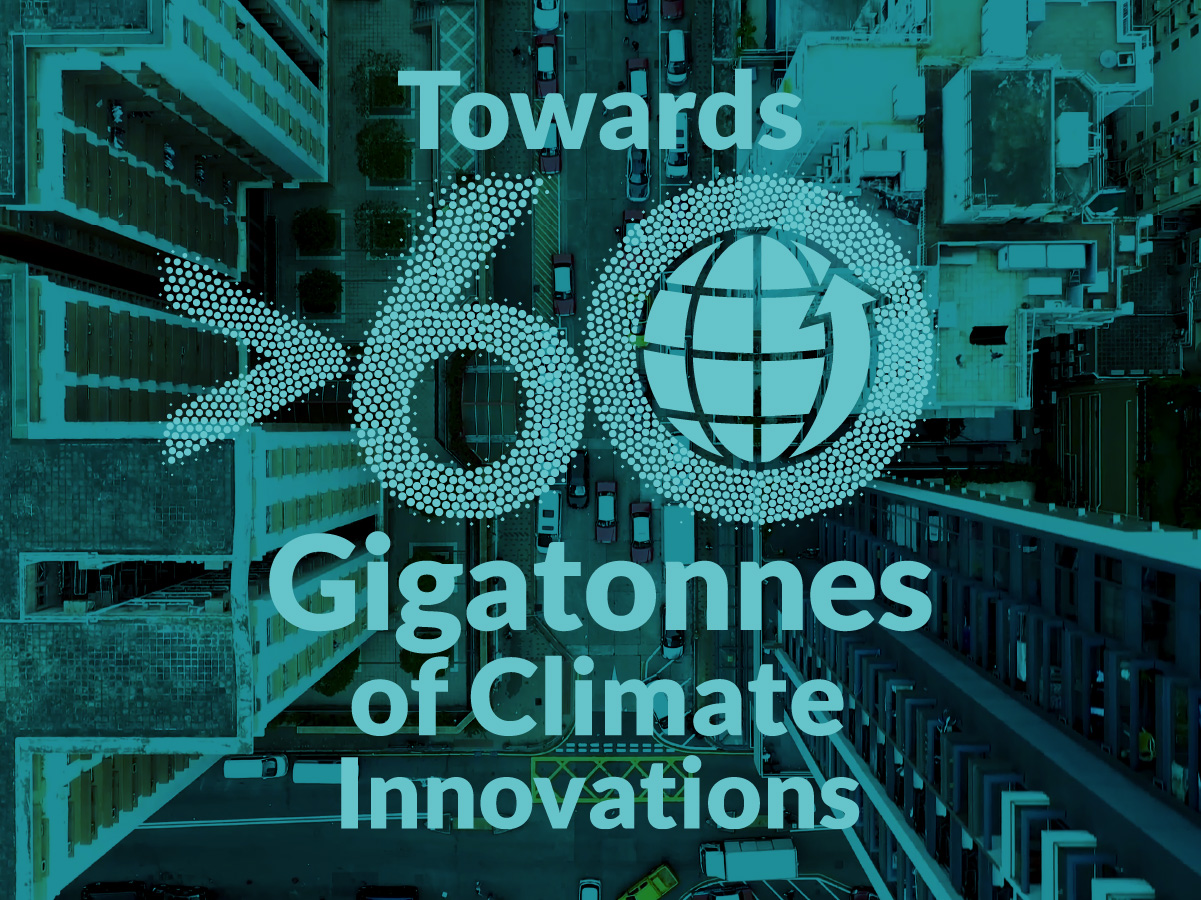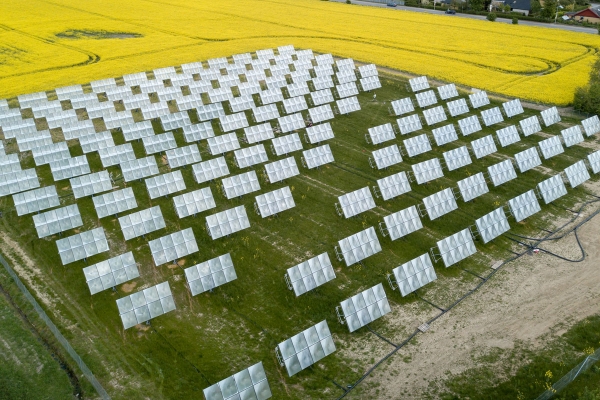Nominated innovations
1000 innovative clean energy solutions and > 150 framework enablers with the potential to deliver more than twelve gigatonnes of avoided emissions by 2030
These assessments are based on a basic avoided emission assessment. The overall concept of avoided emissions is that a solution (product or service) enables the same function to be performed with significantly less GHG emissions. The method of measuring avoided emissions, is to compare a baseline scenario without the enabling solution, with a scenario using the enabling solution; whereby the baseline represents the ‘business as usual’ (BAU) scenario.
These assessments are based on the framework document: The Avoided Emissions Framework (AEF) from September 2020

Create transparency to enable investment
MeetMySources wrote: Consumer brands can only create a business case for investment, in sustainable raw material production practices if they can prove the investment’s positive ecological or social impact to the end consumer. Nowadays „trustmarks“ like brands and certificates are insufficient to establish the required consumer trust in the related impact claims, therefore brands have to provide transparency in form of instantly accessible digital proof points. . Meetmysources is a digital platform which allows consumer brands to directly interact with the raw material producers in their supply chain. Understanding of farmer needs and built-in reward structures allow brands to incentivize and invest into farmers’ sustainable behaviour... Source: EIT Climate KIC's ClimateLaunchPad
Germany

MeetMySources
Create transparency to enable investment
MeetMySources wrote: Consumer brands can only create a business case for investment, in sustainable raw material production practices if they can prove the investment’s positive ecological or social impact to the end consumer. Nowadays „trustmarks“ like brands and certificates are insufficient to establish the required consumer trust in the related impact claims, therefore brands have to provide transparency in form of instantly accessible digital proof points. . Meetmysources is a digital platform which allows consumer brands to directly interact with the raw material producers in their supply chain. Understanding of farmer needs and built-in reward structures allow brands to incentivize and invest into farmers’ sustainable behaviour... Source: EIT Climate KIC's ClimateLaunchPad
Currently unavailable

Create smog-free zones
Degrum wrote: Degrum team designed smog-free bus stops. Our product - green bus-stop can serve as a tram- or a bus- stop, which is at the same time an enclave of clean air. Thanks to unique design of a shelter. And filtering system pollution-free atmosphere can be guaranteed. People who use public transportation will be able to breath clean and breath free while waiting to catch a ride. Reducing exposure time to harmful air pollution will have benefical influence on public transport users among over 400 000 europeans dying prematurely due to smog every year... Source: EIT Climate KIC's ClimateLaunchPad
Poland

Degrum
Create smog-free zones
Degrum wrote: Degrum team designed smog-free bus stops. Our product - green bus-stop can serve as a tram- or a bus- stop, which is at the same time an enclave of clean air. Thanks to unique design of a shelter. And filtering system pollution-free atmosphere can be guaranteed. People who use public transportation will be able to breath clean and breath free while waiting to catch a ride. Reducing exposure time to harmful air pollution will have benefical influence on public transport users among over 400 000 europeans dying prematurely due to smog every year... Source: EIT Climate KIC's ClimateLaunchPad
Currently unavailable

CRAMAL
CRAMAL wrote: Cramal is a combination of saas as well as supply chain as a service which intends to decrease food wastage, promote diversification and increase farmers’ income. With cramal we intend to bring farmers, retailers & food processors on a single platform, which will set up a direct linkage between farmers (producers) and buyers. With the elimination of multiple intermediaries, it will bring down post-harvest food loses from present 45% to 5% amounting to 13billion usd. Further, it will increase farmer’s share in consumer expenditure from present 25% to 65%. With the help of big data & machine learning, cramal will be capable of providing demand and supply forecast to farmers and retailers... Source: EIT Climate KIC's ClimateLaunchPad
India

CRAMAL
CRAMAL
CRAMAL wrote: Cramal is a combination of saas as well as supply chain as a service which intends to decrease food wastage, promote diversification and increase farmers’ income. With cramal we intend to bring farmers, retailers & food processors on a single platform, which will set up a direct linkage between farmers (producers) and buyers. With the elimination of multiple intermediaries, it will bring down post-harvest food loses from present 45% to 5% amounting to 13billion usd. Further, it will increase farmer’s share in consumer expenditure from present 25% to 65%. With the help of big data & machine learning, cramal will be capable of providing demand and supply forecast to farmers and retailers... Source: EIT Climate KIC's ClimateLaunchPad
Currently unavailable

CowStraw laddu for more milk and less methane
Chemlife wrote: Chemlife's cowstraw laddu is nutritious tasty dish (laddu) for dairy cattle to increase the milk yield and enhance profit to farmers. The market for this type of product in developing countries is quiet big as average milk yield of crossbred cows is significantly less compared to those in developed part of the world indicating possible nutritional gap. Our attempt is to fill this gap through cowstraw laddu made out of low cost paddy straw which is considered as agricultural waste, through a novel biotransformation process... Source: EIT Climate KIC's ClimateLaunchPad
India

Chemlife
CowStraw laddu for more milk and less methane
Chemlife wrote: Chemlife's cowstraw laddu is nutritious tasty dish (laddu) for dairy cattle to increase the milk yield and enhance profit to farmers. The market for this type of product in developing countries is quiet big as average milk yield of crossbred cows is significantly less compared to those in developed part of the world indicating possible nutritional gap. Our attempt is to fill this gap through cowstraw laddu made out of low cost paddy straw which is considered as agricultural waste, through a novel biotransformation process... Source: EIT Climate KIC's ClimateLaunchPad
Currently unavailable

Cows of Steel
Cows of Steel wrote: How many of us drink cow milk ? most of us do. Cow milk consumption is expected to increase by 1. 5% per person each year in the five coming years. The problem is that cow milk production has huge environmental impacts. Cow milk production is responsible for 3% of all greenhouse gases emissions in the world! given that these emissions are mostly due to cows, we had the idea of producing milk without cows. . Milk is composed of sugars, nutrients and dairy proteins. Sugars and nutrients can be easily sourced, the challenge lies in producing the dairy proteins. For that, we will use state-of-the-art biotechnology that generates the exact same proteins that are present in cow milk, giving our synthetic milk the exact same taste... Source: EIT Climate KIC's ClimateLaunchPad
Denmark

Cows of Steel
Cows of Steel
Cows of Steel wrote: How many of us drink cow milk ? most of us do. Cow milk consumption is expected to increase by 1. 5% per person each year in the five coming years. The problem is that cow milk production has huge environmental impacts. Cow milk production is responsible for 3% of all greenhouse gases emissions in the world! given that these emissions are mostly due to cows, we had the idea of producing milk without cows. . Milk is composed of sugars, nutrients and dairy proteins. Sugars and nutrients can be easily sourced, the challenge lies in producing the dairy proteins. For that, we will use state-of-the-art biotechnology that generates the exact same proteins that are present in cow milk, giving our synthetic milk the exact same taste... Source: EIT Climate KIC's ClimateLaunchPad
Currently unavailable

Cousing
Cousing wrote: The idea is a shared work and living space to reduce the climate impact from the building sector. This will lead to: decrease in amount of rent. Less loneliness increasing sense of community. Reduced climate and environmental impact. Of course people are challenged to accept this kind of housing but it is worth trying... Source: EIT Climate KIC's Climathon
Norway

Cousing
Cousing
Cousing wrote: The idea is a shared work and living space to reduce the climate impact from the building sector. This will lead to: decrease in amount of rent. Less loneliness increasing sense of community. Reduced climate and environmental impact. Of course people are challenged to accept this kind of housing but it is worth trying... Source: EIT Climate KIC's Climathon
Currently unavailable

Counting Carbon
Counting Carbon wrote: Food accounts for approximately 30% of global greenhouse gas emissions. Taking a number of important factors into account, counting carbon generates a relative score for each food product so that the consumer can easily choose the food products that are best for the environment. By changing consumer behaviour, we can create a competitive advantage for environmentally friendly companies, and drive clean tech innovation along the food supply chain... Source: EIT Climate KIC's ClimateLaunchPad
Switzerland

Counting Carbon
Counting Carbon
Counting Carbon wrote: Food accounts for approximately 30% of global greenhouse gas emissions. Taking a number of important factors into account, counting carbon generates a relative score for each food product so that the consumer can easily choose the food products that are best for the environment. By changing consumer behaviour, we can create a competitive advantage for environmentally friendly companies, and drive clean tech innovation along the food supply chain... Source: EIT Climate KIC's ClimateLaunchPad
Currently unavailable

Cost-efficient vehicle charging
Epspot created an electricty access solution that enables electricty to change owner for short term needs. This can take the form of fast electric vehicle charging. We enable electricty access for mobile individuals and take care of the issues that a real estate operator faces when making their electricity available. We address buildings, mobility and energy. Customers include real estate operators, employers, marinas etc.
Sweden

Epspot AB
Cost-efficient vehicle charging
Epspot created an electricty access solution that enables electricty to change owner for short term needs. This can take the form of fast electric vehicle charging. We enable electricty access for mobile individuals and take care of the issues that a real estate operator faces when making their electricity available. We address buildings, mobility and energy. Customers include real estate operators, employers, marinas etc.
Currently unavailable

Cost-competitive solar heat though optimised lenses
Heliac’s solar collectors produce utility-scale heat at unsubsidized costs they claim is below that of fossil fuels anywhere in the world. By using inexpensive lenses that work like magnifying glasses, it can generate temperatures up to 400 °C. Heliac targets process heat markets responsible for 15% of the global demand. These markets include desalination, district heating and cooling, and heat for numerous other standard industrial processes. Heliac believes their solution is scalable enough to meet any potential demand today.
Denmark
≈100

Heliac
Cost-competitive solar heat though optimised lenses
Heliac’s solar collectors produce utility-scale heat at unsubsidized costs they claim is below that of fossil fuels anywhere in the world. By using inexpensive lenses that work like magnifying glasses, it can generate temperatures up to 400 °C. Heliac targets process heat markets responsible for 15% of the global demand. These markets include desalination, district heating and cooling, and heat for numerous other standard industrial processes. Heliac believes their solution is scalable enough to meet any potential demand today.
≈100Mt CO2e/year

Cost effective desalination of seawater
Ocean Oasis wrote: Water scarcity is a growing challenge in a large part of the world. Desalination of seawater is an energy intensive process and in coastline areas where water scarcity coincides with a significant wave climate, desalination of seawater is an attractive application for utilisation of wave energy. . The ocean oasis desalination device uses wave energy directly to desalinate seawater without going via the production of electricity. It is estimated that the ocean oasis device can deliver water to shore at a cost of 0. 9 usd/m3 and 0. 5 usd/m3 for a nw arica and a south africa wave environment respectively. . The next step in the development of the concept is a small scale demonstration project... Source: EIT Climate KIC's ClimateLaunchPad
Norway

Ocean Oasis
Cost effective desalination of seawater
Ocean Oasis wrote: Water scarcity is a growing challenge in a large part of the world. Desalination of seawater is an energy intensive process and in coastline areas where water scarcity coincides with a significant wave climate, desalination of seawater is an attractive application for utilisation of wave energy. . The ocean oasis desalination device uses wave energy directly to desalinate seawater without going via the production of electricity. It is estimated that the ocean oasis device can deliver water to shore at a cost of 0. 9 usd/m3 and 0. 5 usd/m3 for a nw arica and a south africa wave environment respectively. . The next step in the development of the concept is a small scale demonstration project... Source: EIT Climate KIC's ClimateLaunchPad
Currently unavailable